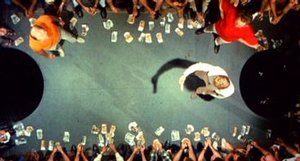
Last week, the DVD and Blu-Ray editions of Wake in Fright (1971) were released. Watching it on DVD, I couldn’t help but think Wake in Fright lives up to its reputation as one the finest cinematic achievements ever produced in this country. Yet until this year it primarily existed in our memories. Thanks to the format, Wake in Fright, and many other titles once relegated to history, can be seen by just about anyone.
Now available for the very first time in its full form, the film was once considered a long-lost classic of Australian cinema until 2004 when the original negatives, tri-separations and music tracks were found by its editor, Anthony Buckley, in a bin marked ‘for destruction’ at an American television station. Painstakingly restored by the NFSA and Atlab/Deluxe, the film screened at the Sydney Film Festival in June this year to rapturous applause, from patrons and critics alike. One of a very small handful of local feature films to ever screen at the Cannes Film Festival at the time of its release, Wake in Fright made another appearance this year when it was selected as a Cannes Classic title by the head of the department, Martin Scorsese, becoming one of only two films ever to screen twice in the history of the festival (the other is Antonioni’s L’avventura, 1960 Palme d’Or winner).
Before its re-discovery, Wake in Fright was practically impossible to see anywhere after the late ‘70s unless you could catch a lone TV screening on the Bill Collins show in the ‘80s, a one-off screening of an inferior print, or a crusty old VHS tape. Remarkable, considering its influence – famed local directors Peter Weir, Bruce Beresford and Fred Schepisi declared it solely responsible for the renaissance of the Australian film in the ’70s. Considering all this, just how much does access to a film influence the way it is remembered?
Just like the transfer from cinema prints to VHS, some titles are taking their sweet time, and others are simply left behind. Only this year have several significant, popular and critically-praised films been released to the public for purchase. These include The Year My Voice Broke (1987), Pure S (1975) and Buddies (1983), the most requested title on australianscreen. Peter Weir’s The Last Wave (1977) is still only available exclusively in the US. These films made a deep impact in Australian cinema history. Surely, there are others like them, awaiting their fair shake, deserving more recognition than from film buffs with an elephant’s memory and a film festival season pass.
A solution may be found in the concept of DVD-on-demand. Recently, major US film studios gave the green light to allow selected retailers to burn titles at DVD kiosks for downloading, equipping them with the same copy-protection technology as their pre-recorded counterparts. Similarly, Warner Home Video announced earlier this year that 150 rare titles from their back catalogue will be available by request from fans. The titles don’t justify a wide DVD release, so instead of allowing them to drift into obscurity, they’ll be available for anyone to purchase by mail order. Archives like the NFSA hold many films that, for varying reasons, don’t have a distributor, but which many people want to watch. What should archives do with these films?



